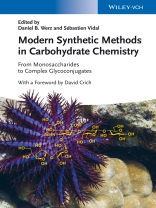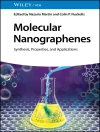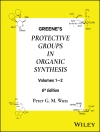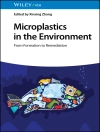The fields of glycochemistry and glycoscience are rich and varied and where much can be learned from Nature. As Nature is not always able to produce carbohydrates in quantities useful for not only in research but also as therapeutic agents, new ways need to be found to optimize the yield. This book presents an overview of the latest developments in the field of carbohydrates, ranging from de-novo approaches via cyclodextrin chemistry to the synthesis of such highly complex glycoconjugates as glycosphingolipids and GPI anchors.
The main emphasis remains on the synthetic aspects making the book an excellent source of information for those already involved in carbohydrate chemistry, as well as for those organic chemists who are beginners in this field. Equally of interest to synthetic chemists, as well as medicinal chemists and biochemists.
قائمة المحتويات
Foreword xv
Preface xvii
List of Contributors xix
1 De Novo Approaches to Monosaccharides and Complex Glycans 1
Michael F. Cuccarese, Jiazhen J. Li, and George A. O’Doherty
1.1 Introduction 1
1.2 De Novo Synthesis of Monosaccharides 4
1.3 Iterative Pd-Catalyzed Glycosylation and Bidirectional Postglycosylation 5
1.3.1 Bidirectional Iterative Pd-Catalyzed Glycosylation and Postglycosylation 6
1.3.2 Synthesis of Monosaccharide Aminosugar Library 7
1.4 Synthesis of Monosaccharide Azasugar 9
1.5 Oligosaccharide Synthesis for Medicinal Chemistry 10
1.5.1 Tri- and Tetrasaccharide Library Syntheses of Natural Product 12
1.5.2 Anthrax Tetrasaccharide Synthesis 17
1.6 Conclusion and Outlook 21
1.7 Experimental Section 22
List of Abbreviations 24
Acknowledgments 25
References 25
2 Synthetic Methodologies toward Aldoheptoses and Their Applications to the Synthesis of Biochemical Probes and LPS Fragments 29
Abdellatif Tikad and Stéphane P. Vincent
2.1 Introduction 29
2.2 Methods to Construct the Heptose Skeleton 29
2.2.1 Olefination of Dialdoses Followed by Dihydroxylation 31
2.2.1.1 Olefination at C-5 Position of Pentodialdoses 31
2.2.1.2 Olefination at C-1 Position of Hexoses 33
2.2.1.3 Olefination at C-6 Position of Hexodialdoses 33
2.2.2 Homologation by Nucleophilic Additions 35
2.2.2.1 Elongation at C-6 of Hexoses 35
2.2.2.2 Elongation at C-1 Position of Aldose 41
2.2.3 Heptose de novo synthesis 44
2.3 Synthesis of Heptosylated Oligosaccharides 46
2.3.1 Synthesis of the Core Tetrasaccharide of Neisseria meningitides Lipopolysaccharide 46
2.3.2 Synthesis of a Branched Heptose- and Kdo-Containing Common Tetrasaccharide Core Structure of Haemophilus influenza Lipopolysaccharides 47
2.3.3 Synthesis of the Core Tetrasaccharide of Neisseria gonorrhoeae Lipopolysaccharide 48
2.3.4 The Crich’s Stereoselective β-Glycosylation Applied to the Synthesis of the Repeating Unit of the Lipopolysaccharide from Plesimonas shigelloides 49
2.3.5 De Novo Approach Applied to the Synthesis of a Bisheptosylated Tetrasaccharide 51
2.4 Synthesis of Heptosides as Biochemical Probes 52
2.4.1 Bacterial Heptose Biosynthetic Pathways 53
2.4.2 Artificial D-Heptosides as Inhibitors of Hld E and Gmh A 54
2.4.3 Inhibition Studies of Heptosyltransferase Waa C 56
2.5 Conclusions 57
2.6 Experimental Part 58
2.6.1 Typical Synthesis of a D-glycero-Heptoside by Dihydroxylation of a C6–C7 Alkene 58
2.6.1.1 Phenyl 1-deoxy-2, 3, 4-tri-O-benzyl-1-thio-D-glycero-α-D-mannoheptopyranoside (167) 58
2.6.2 Typical Synthesis of a L-glycero-Heptoside by Addition of Grignard Reagent Followed by a Tamao–Fleming Oxidation 58
2.6.2.1 Methyl 2, 3, 4-tri-O-benzyl-7-(phenyldimethyl)silane-7-deoxy-L-glyceroα-D-manno-heptopyranoside (170) 59
2.6.2.2 Methyl 2, 3, 4-tri-O-benzyl-L-glycero-α-D-manno-heptopyranoside (171) 60
List of Abbreviations 60
Acknowledgments 61
References 61
3 Protecting-Group-Free Glycoconjugate Synthesis: Hydrazide and Oxyamine Derivatives in N-Glycoside Formation 67
Yoshiyuki A. Kwase, Melissa Cochran, and Mark Nitz
3.1 Introduction 67
3.2 Glycosyl Hydrazides (1-(Glycosyl)-2-acylhydrazines) 68
3.2.1 Formation, Tautomeric Preference, and Stability of Glycosyl Hydrazides 68
3.2.2 Analytical Applications 70
3.2.3 Hydrazides in Synthesis 73
3.2.4 Biologically Active Glycoconjugates 75
3.2.5 Lectin-Labeling Strategies Using Glycosyl Hydrazides 77
3.2.6 Summary of Glycosyl Hydrazides 79
3.3 O-Alkyl-N-Glycosyl Oxyamines 79
3.3.1 Formation, Configuration, and Stability of O-Alkyl-N-Glycosyloxyamines 79
3.3.2 Uses of O-Alkyl-N-Glycosyl Oxyamines 80
3.4 N, O-Alkyl-N-Glycosyl Oxyamines 80
3.4.1 Uses of N-Alkyl-N-Glycosyloxyamines 83
3.4.2 Glycobiology 83
3.4.3 Medicinal Chemistry 86
3.4.4 Carbohydrate Synthesis Using N-Alkyloxyamines 87
3.4.5 Summary of N-Alkyl-N-Glycosyl Oxyamines 89
3.5 Concluding Remarks and Unanswered Questions 90
3.6 Procedures 91
3.6.1 Formation of the p-Toluenehydrazide Glycosides 91
3.6.2 Formation of Azido-Glycosides 91
3.6.3 Formation of Glycosyl Phosphate 92
3.6.4 Formation of N, O-Dialkyloxylamine Glycoside 92
List of Abbreviations 93
Acknowledgment 93
References 94
4 Recent Developments in the Construction of cis-Glycosidic Linkages 97
Alphert E.Christina, Gijsbert A.vander Marel, and Jeroen D.C.Codée
4.1 Introduction 97
4.2 Cis-Glycosylation 97
4.3 Conclusion 120
Acknowledgments 120
List of Abbreviations 120
References 121
5 Stereocontrol of 1, 2-cis-Glycosylation by Remote O-Acyl Protecting Groups 125
Bozhena S. Komarova, Nadezhda E. Ustyuzhanina, Yury E. Tsvetkov, and Nikolay E. Nifantiev
5.1 Introduction 125
5.2 Stereodirecting Influence of Acyl Groups at Axial and Equatorial O-3: Opposite Stereoselectivity Proves Anchimeric Assistance 125
5.3 Acyl Groups at O-4 in the galacto Series: Practical Synthesis of α-Glycosides: Complete Stereoselectivity 135
5.4 Lack of Stereocontrolling Effect of Acyl Groups at Equatorial O-4 in 4 C 1 Conformation 143
5.5 Effect of Substituents at O-6 145
5.6 Interplay of Stabilized Bicyclic Carbocation and Two H Conformations of Oxocarbenium Ions 150
5.7 Conclusion 154
5.8 Key Experimental Procedures 155
5.8.1 Example of Stereocontrolled α-Fucosylation: Synthesis of Allyl 3-O-acetyl-4-O-benzoyl-2-O-benzyl-α-L-fucopyranosyl-(1 → 3)-4-O-benzoyl-2-O-benzyl-α-L-fucopyranoside(85)155
5.8.2 Example of Stereocontrolled α-Glucosylation: Synthesis of Methyl 2, 3, 4-tri-O-benzoyl-α-L-rhamnopyranosyl-(1 → 3)-[3, 6-di-O-acetyl-2, 4-di-O-benzyl-α-D-glucopyranosyl-(1 → 6)]-2-O-benzoyl-4-O-benzyl-β-Dglucopyranosyl)-(1→ 3)-[6-O-benzoyl-2, 3, 4-tri-O-benzyl-α-Dglucopyranosyl-(1 → 4)]-2-zido-6-O-benzyl-2-deoxy-α-Dgalactopyranoside (119) 155
List of Abbreviations 156
References 156
6 Synthesis of Aminoglycosides 161
Yifat Berkov-Zrihen and Micha Fridman
6.1 Introduction 161
6.2 Amine-Protecting Group Strategies 163
6.2.1 Chemoselective Amine Group Manipulations 163
6.3 Controlled Degradation of Aminoglycosides 165
6.4 Chemoselective Alcohol-Protecting Group Manipulations 167
6.5 Strategies for Glycosylation of Aminoglycoside Scaffolds 171
6.6 Synthesis of Amphiphilic Aminoglycosides 173
6.7 Chemoenzymatic Strategies for the Preparation of Aminoglycoside Analogs 176
6.8 Novel Synthetic Strategies to Overcome Resistance to Aminoglycosides 179
6.9 Conclusions and Future Perspectives 181
6.10 Selected Synthetic Procedures 182
Acknowledgments 186
List of Abbreviations 186
References 187
7 Synthesis of Natural and Nonnatural Heparin Fragments: Optimizations and Applications toward Modulation of FGF2-Mediated FGFR Signaling 191
Pierre-Alexandre Driguez
7.1 Introduction 191
7.2 Total Synthesis of Standard HPN Fragments 193
7.3 Total Synthesis of Modified HPN Fragments: Some Synthetic Clues 199
7.3.1 Modifications on the Aglycon Moiety 199
7.3.2 Modifications at Position 2 of Glucosamines 201
7.3.3 Modifications of the O-Sulfonatation Pattern 203
7.4 Alternative Synthetic Methods: Means to Build Libraries 208
7.4.1 Synthesis of Tetrasaccharide Mixtures Followed by Purification 210
7.4.2 Modular Synthesis of HPN/HS Oligosaccharides 210
7.5 Biological Evaluation 212
7.6 Conclusion and Outlook 214
7.7 Experimental Section (General Procedures) 214
7.7.1 General Conditions for Coupling Reactions 214
7.7.2 General Conditions for Delevulinoylations 215
7.7.3 General Conditions for Olefin Cross Metathesis Reactions 215
7.7.4 General Conditions for Transesterifications 215
7.7.5 General Conditions for Desilylations 215
7.7.6 General Conditions for O-Sulfonatations 215
7.7.7 General Conditions for Saponifications 216
7.7.8 General Conditions for the Catalytic Reductions 216
7.7.9 General Conditions for N-Sulfations 216
7.7.10 General Conditions for N-Acylations 216
Acknowledgments 217
List of Abbreviations 217
References 218
8 Light Fluorous-Tag-Assisted Synthesis of Oligosaccharides 221
Rajarshi Roychoudhury and Nicola L. B. Pohl
8.1 Introduction 221
8.2 Fluorous-Protecting Groups and Tags Amenable to Fluorous Solid-Phase Extraction in Carbohydrate Synthesis 222
8.2.1 Mono- and Diol Protecting Groups 222
8.2.2 Amine Protection 224
8.2.3 Phosphate Protection 224
8.3 Light Fluorous-Protecting Groups with Potential Use in Oligosaccharide Synthesis 226
8.3.1 Alcohol Protection 226
8.3.2 Carboxylic Acid Protection 228
8.3.3 Amine Protection 228
8.4 ‘‘Cap-Tag’’ Strategies or Temporary Fluorous-Protecting Group Additions 229
8.5 Double-Tagging Carbohydrates with Fluorous-Protecting Groups 231
8.6 Other Advantages to Fluorous-Assisted Oligosaccharide Synthesis 232
8.6.1 Automated Oligosaccharide Synthesis Using Fluorous Tags 232
8.6.2 Fluorous-Based Carbohydrate Microarrays 234
8.7 Conclusions and Outlook 234
8.8 Experimental Section 235
8.8.1 Synthesis of 6-(Benzyl 2-bromo-3, 3, 4, 4, 5, 5, 6, 6, 7, 7, 8, 8, 9, 9, 10, 10, 10- heptadecafluorodecyl phosphate)-1, 2, 3, 4-di-O-isopropylidene-α-Dgalactopyranose 235
8.8.2 Synthesis of 3-(Perfluorooctyl)propanyloxybutenyl-3, 4, 6-tri-O-acetyl-2- deoxy-2-(p-nitrobenzyloxycarbonylamino)-β-D-glucopyranoside 236
8.8.3 Synthesis of 3-(Perfluorooctyl)propanyloxybutenyl-4-O-benzyl-3, 6-di-O- (2-O-acetyl-3, 4, 6-O-tribenzyl-α-D-mannopyranoside)-2-O-pivaloyl-α-Dmannopyranoside 236
Acknowledgments 237
List of Abbreviations 237
References 237
9 Advances in Cyclodextrin Chemistry 241
Samuel Guieu and Matthieu Sollogoub
9.1 Introduction 241
9.1.1 Nomenclature of Modified Cyclodextrins 243
9.2 General Reactivity, Per- and Monofunctionalization 244
9.2.1 General Reactivity of Cyclodextrins 244
9.2.2 Perfunctionalization of Each Position 245
9.2.3 Monofunctionalization 247
9.2.3.1 Use of Reagent in Default 247
9.2.3.2 Use of Supramolecular Inclusion Complex 248
9.2.4 Random Multifunctionalization and Multidifferentiation 249
9.3 Capping Reagents for Direct Modification 250
9.3.1 Difunctionalization: Capping the Cyclodextrin 250
9.3.1.1 Single Cap 250
9.3.1.2 Double Capping 253
9.3.2 Unsymmetrical Caps 254
9.3.3 Modification of Capped Cyclodextrins 256
9.3.3.1 Addition of Another Functionality 256
9.3.3.2 Opening the Caps 256
9.4 Bulky Reagents for Direct Modifications 259
9.4.1 Trityl and Derivatives 260
9.4.2 Triphenylphosphine 261
9.4.3 Selective Transfer 262
9.5 Selective Deprotections 263
9.5.1 Diisobutylaluminum Hydride (DIBAL-H) as Deprotecting Agent 263
9.5.1.1 General Mechanism 263
9.5.1.2 Application to Cyclodextrins 265
9.5.2 Second Deprotection 269
9.5.2.1 Monoazide Cyclodextrins 269
9.5.2.2 Deoxy and Bridged Cyclodextrins 269
9.5.3 Third Deprotection 276
9.6 Conclusion and Perspectives 278
9.7 Experimental Procedures 279
9.7.1 Tetrafunctionalization of the Primary Rim of α-Cyclodextrin Using Supertrityl 279
9.7.2 Double Deprotection of Perbenzylated α-orβ-Cyclodextrins Using Dibal-h 279
List of Abbreviations 280
References 280
10 Design and Synthesis of GM1 Glycomimetics as Cholera Toxin Ligands 285
José J. Reina and Anna Bernardi
10.1 Introduction 285
10.2 Cholera Toxin and Its Specific Membrane Receptor, the GM 1
Ganglioside 287
10.2.1 Interaction of Cholera Toxin and GM1-os 288
10.3 Rational Design of GM1-os Mimics as Cholera Toxin Inhibitors and Synthesis of First-Generation Ligands 289
10.3.1 Second-Generation Mimics of GM1 Ganglioside: Replacement of the Sialic Acid Moiety 293
10.4 Third Generation of GM1 Ganglioside Mimics: Toward Nonhydrolyzable Cholera Toxin Antagonists 298
10.5 Conclusions 304
10.6 Experimental Section 305
10.6.1 Multigram-Scale Synthesis of (1S, 2S)-Cyclohex-4-ene-1, 2-dicarboxylic acid 7 305
10.6.1.1 Synthesis of (1S, 2R)-Cyclohex-4-ene-1, 2-carboxylic acid monomethylester 9 305
10.6.1.2 cis–trans Equilibration of the Monomethylester: Synthesis of 10 305
10.6.1.3 Synthesis of (1S, 2S)-Cyclohex-4-ene-1, 2-dicarboxylic acid 7 306
10.6.2 Synthesis of α-andβ-2, 3, 4, 6-tetra-O-Acetyl-1-C-(2-oxo-ethyl)-Dgalactopyranose 49 and 50 307
10.6.2.1 Synthesis of 2, 3, 4, 6-tetra-O-Acetyl-1-C-allyl-α-D-galactopyranose 48 307
10.6.2.2 Synthesis of 2, 3, 4, 6-tetra-O-Acetyl-1-C-(2-oxo-ethyl)-α-D-galactopyranose 49 307
10.6.2.3 Synthesis of 2, 3, 4, 6-tetra-O-Acetyl-1-C-(2-oxo-ethyl)-β-D-galactopyranose 50 307
Acknowledgments 308
List of Abbreviations 308
References 309
11 Novel Approaches to Complex Glycosphingolipids 313
Hiromune Ando, Rita Pal, Hideharu Ishida, and Makoto Kiso
11.1 Introduction 313
11.2 Syntheses of Complex Glycans of Gangliosides 314
11.2.1 Glycan Moiety of Ganglioside Hp-s6 (Hp-s6 Glycan) 315
11.2.2 Glycan Moiety of Ganglioside HPG-7 (HPG-7 Glycan) 315
11.2.3 Glycan Moiety of Ganglioside AG-2 (AG-2 Glycan) 316
11.2.4 Glycan Moiety of Ganglioside GP1c (GP1c Glycan) 319
11.3 Total Syntheses of Complex Gangliosides 319
11.3.1 Synthesis of Ceramide Moiety 319
11.3.2 Glucosyl Ceramide Cassette Approach 319
11.3.3 Total Synthesis of Ganglioside GQ1b 323
11.3.4 Total Synthesis of Ganglioside Gal NAc-GD1a 323
11.3.5 Total Synthesis of Ganglioside LLG- 3 326
11.3.5.1 Chemical Synthesis 326
11.3.5.2 Chemo-Enzymatic Synthesis 329
11.4 Conclusion and Outlook 329
11.5 Experimental Section 329
11.5.1 Synthesis of N-Troc Sialyl Donor 2 329
11.5.2 Synthesis of N-Troc Sialyl Galactoside 45 330
List of Abbreviations 331
References 332
12 Chemical Synthesis of GPI Anchors and GPI-Anchored Molecules 335
Ivan Vilotijevic, Sebastian Götze, Peter H. Seeberger, and Daniel Varón Silva
12.1 Introduction 335
12.2 Challenges in the Synthesis of GPIs 337
12.3 Tools for Synthesis of GPIs 339
12.3.1 Synthesis of Building Blocks 340
12.3.2 Glycosylation Strategy 341
12.3.3 Phosphorylation Strategies 342
12.3.4 Strategic Synthesis Planning 343
12.4 Synthesis of GPIs with Linear Glycan Core 346
12.4.1 Synthesis of the GPI from Plasmodium falciparum Using n-Pentenyl Orthoesters 346
12.4.2 Synthesis of the GPI from Saccharomyces cerevisiae Using Trichloroacetimidates 349
12.4.3 Synthesis of Unsaturated GPIs from Trypanosoma cruzi 351
12.5 Synthesis of GPIs with Branched Glycan Core 353
12.5.1 Synthesis of the Trypanosoma brucei VSG GPI Using Glycosyl Halides 353
12.5.2 Synthesis of T. brucei VSG GPI from Chalcogenide Glycosides of Finely Tuned Reactivity 356
12.5.3 A General Synthetic Strategy for the Synthesis of Branched GPIs 357
12.6 GPI Derivatives for Biological Research 361
12.7 Synthesis of GPI-Anchored Peptides and Proteins 363
12.7.1 Synthesis of the GPI-Anchored Skeleton Structure of Sperm CD52 via Direct Amide Coupling 364
12.7.2 Semisynthesis of GPI-Anchored Cellular Prion Protein via Native Chemical Ligation 364
12.8 Conclusions and Outlook 366
Acknowledgments 368
List of Abbreviations 368
References 370
Index 373
عن المؤلف
Daniel B. Werz is Professor at the Technical University of Braunschweig, Germany. Having obtained his diploma (2000) as well as his Ph.D. (2003) from University of Heidelberg he spent over two years of postdoctoral research with Peter H. Seeberger at ETH Zurich, Switzerland, before starting his independent career at the University of Gottingen, Germany. In spring 2013 he took up his present position as an associate professor in Braunschweig. Prof. Werz has authored and co-authored over 100 scientific publications and has received several scientific fellowships and awards, including the Ruprecht Karls Award of the University of Heidelberg (2004), a Feodor Lynen Fellowship of the Alexander von Humboldt Foundation (2004), the Klaus Grohe Award of the German Chemical Society (2006), the Emmy Noether Fellowship of the German Research Foundation (2007), the Glyco Thera Award (2010) and the highly prestigious Dozentenstipendium of the Chemical Industry Fund (2011).
Sebastien Vidal is Charge de Recherche at Centre National de la Recherche Scientifique (CNRS) and is responsible of a small research team at ICBMS (Universite Claude Bernard Lyon 1, France). In 2000, he has obtained his Ph D in organic chemistry from Universite Montpellier II (France) working on mannose 6-phosphate analogues. He then continued as a postdoctoral fellow in the group of J. Fraser Stoddart at University of California, Los Angeles for three years to design synthetic methodologies for the preparation of glycodendrimers. After another postdoctoral position at the National Renewable Energy Laboratory (NREL, Golden, Colorado, USA) under the guidance of Joseph J. Bozell, he then moved back to France and was appointed as a CNRS fellow in 2004. Dr. Vidal has co-authored over 60 scientific publications devoted to organic and carbohydrate chemistry.












